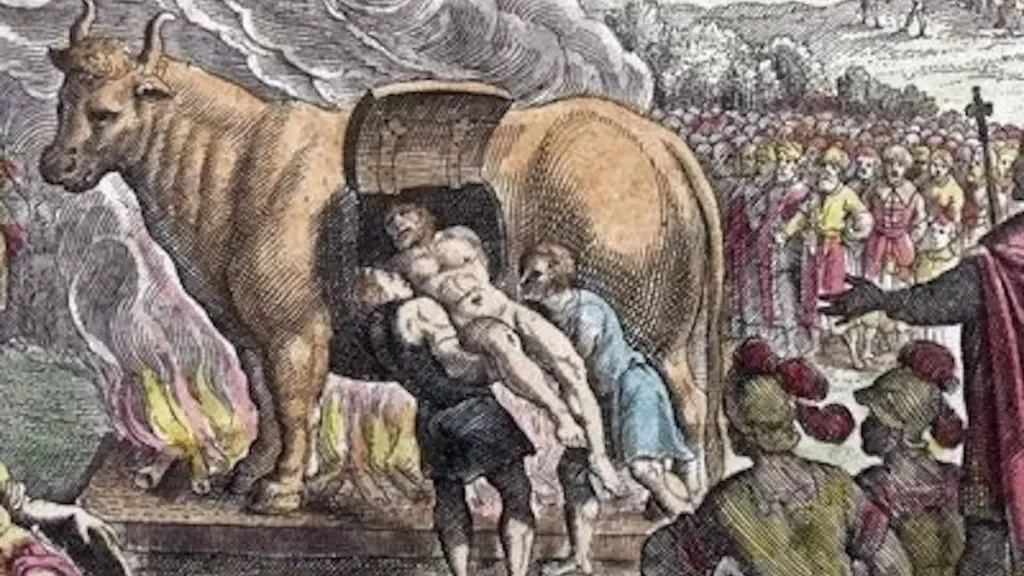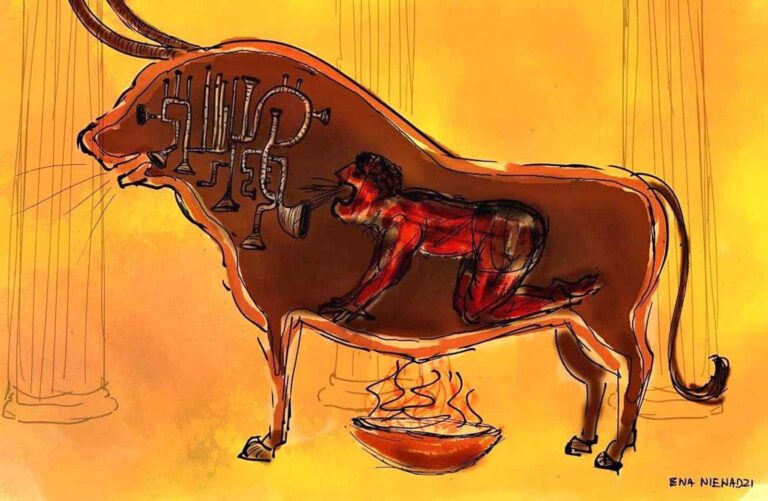The Brazen Bull: A Gruesome Torture Device Of Ancient Greece
Could a single invention encapsulate both the ingenuity and the depravity of a civilization? The brazen bull, a chilling testament to the brutality of ancient Greece, stands as a symbol of cruelty, offering a glimpse into a dark chapter of human history.
The brazen bull, also known by various names such as the bronze bull, Sicilian bull, bellowing bull, or bull of Phalaris, was a device engineered for torture and execution in ancient Greece. Historical accounts, notably those of Diodorus Siculus, describe its origins. According to his writings in the Bibliotheca Historica, the bull was the brainchild of Perilaus (or Perillus) of Athens. He presented his creation to Phalaris, the tyrant of Akragas, a Greek city in Sicily, proposing it as a novel and particularly effective method of punishment.
While the details surrounding the brazen bull remain shrouded in historical debate, with some scholars questioning the extent of its actual use, its legend has certainly endured. The methods of execution and torture in the ancient world were often barbaric, ranging from common practices like hanging, drawing, and quartering to the more elaborate use of instruments such as the rack. The brazen bull, however, appears to have occupied a special place in the collective imagination, contributing to its enduring reputation as a symbol of extreme cruelty.
This gruesome apparatus, reputedly conceived in the 6th century B.C.E., was designed to be a particularly horrifying instrument of capital punishment. Crafted from bronze, the statue was shaped in the likeness of a bull and featured an opening on one side, through which the condemned would be placed. Bronze, an alloy of copper and tin, was a material commonly used in ancient times for various purposes, reflecting the technological sophistication of the era. The brazen bull torture device epitomizes the dark side of this progress.
The specifics of the bulls operation are unsettling. Once the victim was sealed inside, a fire would be lit beneath the structure. The bronze would heat, slowly turning the interior into a fiery furnace. The chilling innovation, according to accounts, was the inclusion of a system of pipes and whistles. These were designed to transform the screams of the suffering into sounds resembling the snorting of a bull. Phalaris, the tyrant of Akragas, allegedly found this effect particularly amusing, further compounding the horror.
The instrument's purported creator, Perilaus of Athens, is said to have experienced a cruel twist of fate. Legend has it that Phalaris, wanting to test the device, tricked Perilaus into entering the bull himself. Some accounts claim Perilaus was removed before his death, while others suggest he perished within his own creation. Following this event Phalaris would later meet his end after the akragians revolted against him. This event added another layer of tragic irony to the story. This grim account highlights the cruelty that defined the age.
The use of the brazen bull extended beyond its immediate function as an instrument of death. Its very existence served as a warning, a deterrent aimed at instilling fear and maintaining order through terror. The brazen bull highlights the lengths to which leaders would go to preserve power, at the expense of human life. Those convicted of serious crimes, notably treason, were subject to the bull's horrific punishment. The brutal reality of this method underscores the complex moral landscape of ancient Greece.
The brazen bull was eventually taken to Carthage, and later, after the fall of that city to the Romans, envoys from Sicily were allowed to take the bull. The bull's legend has survived through the centuries, maintaining its power to shock and horrify. The Catholic Church officially denies that some historic Christian saints were killed by the legendary brazen bull.
The image of the brazen bull, conjures a scene of agony. The victim, trapped within the confines of the bronze beast, faced a slow, agonizing demise. This underscores the value placed on fear as a tool of governance.
The brazen bull, the embodiment of pain and suffering, remains a stark reminder of human cruelty. It serves as a reminder of the darkness that can exist, offering a cautionary tale about the abuse of power.
The story of the brazen bull is a potent reminder of the excesses of absolute power. It stands as a chilling testament to a past where torture and execution were public spectacles. Its enduring legacy serves as a stark reminder of the importance of human rights and the fight against brutality.
| Aspect | Details |
|---|---|
| Name | The Brazen Bull, Bronze Bull, Sicilian Bull, Bull of Phalaris, Bellowing Bull |
| Origin | Ancient Greece |
| Inventor | Perilaus (or Perillus) of Athens (Attic sculptor) |
| Proposed to | Phalaris, the tyrant of Akragas (Agrigento), Sicily |
| Date of Invention | Approximately 6th century B.C.E. (around 560 BC) |
| Material | Bronze |
| Design | Hollow bronze statue in the shape of a bull, with an opening for victims and a fire pit beneath |
| Purpose | Torture and execution of criminals |
| Method of Execution | Victims were locked inside the bull, and a fire was lit beneath, slowly roasting them alive. |
| Additional Features | Pipes and whistles designed to convert the screams of the victim into sounds like a bull's snorting. |
| Victims | Criminals, including those accused of treason. |
| Notable Accounts | Diodorus Siculus (Bibliotheca Historica) and Livius |
| Fate of the Inventor | According to legend, Perilaus was the first to be tested in the bull. |
| Fate of Phalaris | Akragians revolted against him and he died. |
| Historical Significance | Symbol of extreme cruelty, the abuse of power, and a cautionary tale of historical brutality. |
| Legacy | The legend persists in modern times, though its historical accuracy is debated |
| Modern Relevance | Serves as a reminder of historical brutality and cautionary tale of the abuse of power. |
| Crimes Punished | Treason and potentially other serious crimes against the state or ruler. |
| Geographical Location | Ancient Greece, particularly Akragas (Sicily), and later Carthage. |
| Material Construction | Made entirely of bronze |
| Size | Size of a real bull |
| Other names | Bronze Bull, Sicilian Bull, Bull of Phalaris, Bellowing Bull |
| Moral | Excesses of absolute power. |
| Link for reference | Encyclopedia Britannica - Brazen Bull |



Detail Author:
- Name : Dorian McKenzie
- Email : qchamplin@hotmail.com
- Birthdate : 1994-07-11
- Address : 78600 Lesch Ports Apt. 116 Cullenborough, NY 15738-5714
- Phone : 1-442-202-1681
- Company : Fisher-Gutmann
- Job : Fitness Trainer
- Bio : Mollitia quisquam minus placeat harum omnis excepturi quia est. Sit cumque perferendis voluptatem commodi vero dolores.